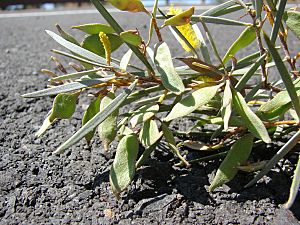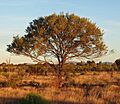Mulga facts for kids
Quick facts for kids Mulga |
|
|---|---|
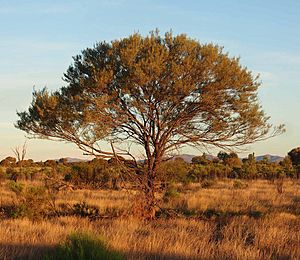 |
|
| Conservation status | |
| Scientific classification | |
| Genus: |
Acacia
|
| Species: |
aneura
|
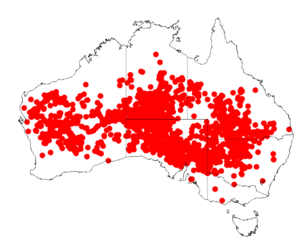 |
|
| Occurrence data from AVH | |

The Mulga (scientific name: Acacia aneura) is a special type of shrub or small tree. It grows naturally in the dry, remote areas of Australia, often called the outback. The Mulga tree is so common and important in these areas that its home is even named after it – the mulga habitat! You can find large areas of Mulga in places like the Western Australian mulga shrublands and the Mulga Lands in Queensland.
Contents
All About the Mulga Tree

Mulga trees can look very different from one another. They vary in height, shape, and even the look of their leaves and seed pods. Some Mulgas grow into dense forests up to 15 meters (about 50 feet) tall. Others might be small, low shrubs spread far apart, almost like heath plants. Most often, Mulgas are tall shrubs.
Even though Mulgas are usually small, they can live for a very long time. A Mulga tree that isn't disturbed by fire can live for 200 to 300 years!
How Mulga Survives in the Desert
The Mulga tree has amazing ways to survive in the Australian desert. Like many other Acacia species, it has thick, tough leaves called phyllodes. These leaves are designed to lose very little water. They have a lot of oil, tiny pores that are sunken in, and many small hairs. All these features help the tree save water.
When it's very dry, Mulga trees drop many of their leaves. These fallen leaves create a layer of mulch on the ground. This mulch helps recycle nutrients back into the soil for the tree.
Unlike many plants, Mulga trees don't have thorns. Their needle-like leaves stand straight up. This helps them avoid the strong midday sun and instead catch the cooler light in the morning and evening. When it rains, the leaves and branches guide the water down to the soil right next to the trunk. This means the tree gets more than three times the effective rainfall!
Mulga roots also grow deep into the soil to find hidden moisture. These roots also work with tiny bacteria. These bacteria help the tree by taking nitrogen from the air and putting it into the soil. This is important because the soil where Mulgas grow is often very old and doesn't have many nutrients.
Where Mulga Lives and Grows
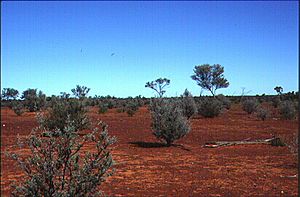
Mulga savannas and Mulga grasslands cover about 20% of Australia. That's a huge area, about 1.5 million square kilometers! In most of these areas, the average rainfall is about 200–250 millimeters (8–10 inches) per year. However, in some parts of New South Wales and Queensland, it can get as much as 500 millimeters (20 inches) of rain. Mulga can even grow in places with as little as 50–60 millimeters (2–2.5 inches) of rain per year.
Mulga needs both summer and winter rain to grow well. It doesn't grow in dry areas that only get rain in one season.
Plants in Mulga Woodlands
Mulga woodlands are unique and found across a wide area. The main tree in these woodlands is the Mulga. Sometimes, another tree called poplar box (Eucalyptus populnea) grows alongside it, especially in eastern areas.
The amount of plants growing on the ground in Mulga woodlands depends on how dense the Mulga trees are. If the Mulga trees are very close together, there might be almost no plants on the ground. In more open areas, you might see grasses like wire grasses (Aristida species), mulga oats (Monocather species), and wanderrie (Eriachne species). Other important woody plants in these areas include hop bushes (Dodonaea species) and Eremophila.
Unlike the eucalypt forests that cover much of Australia, Mulga woodlands don't handle regular fires very well. Many plants in Mulga communities, including the Mulga itself, can't easily grow back after a fire. Instead, they rely on their seeds to survive. Many plants produce hard, woody fruits or seeds that can survive intense heat. Sometimes, the heat from a fire even helps these seeds to sprout! Seeds can also stay hidden in the soil for a long time, waiting for the right conditions to grow.
Different Kinds of Mulga
Because Mulga trees are so varied, scientists have studied them a lot. They might eventually split A. aneura into several different species. Here are some of the recognized varieties:
- A. a. var. aneura
- A. a. var. argentea
- A. a. var. fuliginea
- A. a. var. intermedia
- A. a. var. macrocarpa
- A. a. var. major
- A. a. var. microcarpa
- A. a. var. pilbarana
- A. a. var. tenuis
Uses of the Mulga Tree
Mulga in Agriculture
Mulga trees can be planted with sandalwood trees. The Mulga acts as a "host tree" for the sandalwood. The flowers of the Mulga tree also provide food for bees, especially when there's enough water around.
Mulga is very important for farming in Australia, especially for raising animals. Even though Mulga leaves have some tough parts that are hard to digest, they are a valuable food source for livestock like cattle and sheep. This is especially true during dry periods. The leaves taste good to animals and provide a good amount of protein.
The seeds of the Mulga tree were once used by Aboriginal people to make seedcakes. The mulga apple is a type of insect gall (a growth on the plant) that Aboriginal people often ate. Mulga tree gum, called ngkwarle alkerampwe in the Arrernte language, is a sweet, honey-like treat found on Mulga branches.
Mulga Wood
The wood from Mulga trees is very strong and lasts a long time, even when buried in soil. Because of this, it's often used for fence posts. Mulga wood is quite heavy, with a density of about 850–1100 kilograms per cubic meter. It also makes good firewood, and you can produce high-quality charcoal from it.
Mulga wood was extremely important to Indigenous Australians in Central Australia. It was a great hardwood for making many tools and items. These included digging sticks, woomeras (spear-throwers), shields, and wooden bowls.
Images for kids



